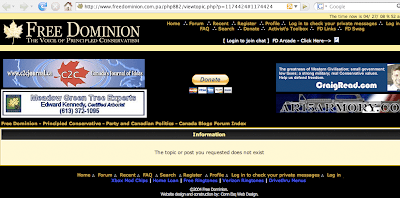Updated at the bottom.
In Sept. 2003, someone posted an ugly racist slur about Senator Anne Cools at the racist freedomsite.com. The poster's IP was recorded by the site's software and subsequently recovered and released by the site's owner,
Marc Lemire: 66.185.84.204, which has the hostname
wc09.mtnk.rnc.net.cable.rogers.com.
This very hostname reports important information that has been overlooked. First, the "wc" in
wc09.mtnk abbreviates
web-cache; this IP is web-cache no. 9 of a bank of caching proxy servers in Newkirk Road, Thorn Hill: mt
nk presumably abbreviates
Metro Newkirk. (
Rogers has an office there.) Web-caching proxies are used by Internet companies such as Rogers to save bandwidth -- copies of web-pages are stored on Rogers' proxy, and only if a page is not stored there does traffic get forwarded to a website; when the traffic gets there, however, the IP that is logged is that of the proxy, not of the original requester.
66.185.84.204 is one of 42 such proxies in the Rogers stable, and they were (are?) arranged in three banks of fourteen at Wolfedale in Mississauga (abbreviated to wlfdle), York Mills in Toronto (ym), and Newkirk in Richmond Hill (mtnk) (see
here). Rogers routed all its traffic though these servers -- or at least the traffic of all users who used the proxying function. (An old Rogers FAQ,
quoted here, encourages its use, but also gives instructions on how to turn it off if it isn't helping.)

That 66.185.84.204 was a web-caching proxy explains a lot. It explains, for example, why it is so easy to find the IP being used in these months: dozens of different users of this IP can be identified for every month, including
September,
October, and
November 2003, when the Cools post was made. For your own curiosity, take your own IP (it is listed in the widget to the right) and google it. Do you see any traces of your own surfing? I can't find any of mine. Why are hundreds of instances of 66.185.84.204 so easy to find? Because as a proxy it was through-putting hundreds or thousands or tens of thousands of times more traffic than an IP assigned to an individual subscriber.
This also explains why we find such a wide variety of individuals using this IP in the months that the Cools post was made. Some of them could read Vietnamese (
here and
here), Tamil (
here), Korean (
here), and Danish (
here). And they seem to come from a wide variety of locations in Ontario: London (
here and
here), Waterloo (
here), Aurora (
here), and (as we know from the present controversy) Ottawa. Again, this is because it's a proxy -- and these are all areas served by Rogers and so any traffic from them might be routed through one of Roger's proxies.
That 66.185.84.204 is a proxy is clear, as is the fact that there seem to be only 42 such proxies to serve all of Rogers' customers (they're listed
here).

So, what does this mean about the Cools poster? One might be tempted to divide 42 proxies into the number of Rogers customers to come up with a notional pool in which the Cools poster resided. It seems clear, however, that individual subscribers are not tied to a single proxy, or indeed to a single bank of proxies. I began this investigation after noting that IPs in the 86.185.84.xxx-range often shift quickly back and forth, a phenomenon that I tried to map out with the string-ball to the left (see
here). These shifting IPs, however, are two of the banks of web-caching proxies (the wlfdle and mtnk), and the shifting of proxies is the necessary and natural result of Rogers' effort to achieve "load balancing", by which traffic to and from Rogers servers was rerouted to keep traffic moving efficiently (see
here).
Although the proxies can change, they do not seem assigned randomly, either. The IPs associated with the prolific editor of numerous Thomas the Tank Engine articles in wikipedia (
here,
here, and
here) seem to suggest that a Rogers subscriber had a "home" proxy; that he might be shifted by Rogers to another proxy for load-balancing, only soon to return to his proxy "home".
So, how many potential Rogers customers might have made that racist Cools post? Probably all of them. As we have seen (
here), the proxies are not geographically limited; each seems to be able to serve all areas of the province.
Now, according to
this, Rogers had 800,000 internet subscribers in March 2004. The same link states that 90% of cable subscribers are in Ontario, which implies a pool of about 700,000.
The Cools poster could be almost any one of them.
Update. The best previous attempt to explain this matter from a technical perspective was that of Lance at
Catprint in the Mash (his work was copied, pasted, and embraced at
FreeDominion). He has now withdrawn his explanation in favour of mine
here, and in the comments to this post.
Update 3. I have now acquired copies of actual logs that Klatt used in his testimony, and these prove that 90sAREover's computer was different from the one Warman used: see
here.
Comments are open, but please see my Comment Policy. Comments that fail those standards will be rejected.



